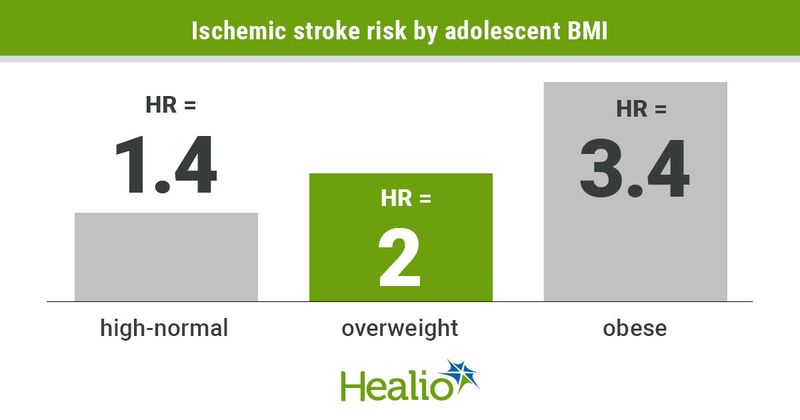Elevated BMI in adolescence tied to future ischemic stroke risk
High BMI in adolescence was associated with ischemic stroke risk regardless of diabetes status, according to a study published in Stroke.
“Adults who survive stroke earlier in life face poor functional outcomes, which can lead to unemployment, depression and anxiety. The direct and indirect costs attributed to stroke prevention and care are high and expected to keep increasing since the rate of stroke continues to rise,” Gilad Twig, MD, MPH, PhD, an associate professor in the Israel Defense Forces (IDF) Medical Corps and the department of military medicine, Faculty of Medicine of the Hebrew University in Jerusalem, said in a press release.

The researchers analyzed 1,900,384 Israeli adolescents (mean age, 17 years; 58% men) from 1985 to 2013. The cohort was stratified by BMI: underweight, defined as less than fifth percentile of BMI as defined by the CDC; low-normal, defined as the fifth through 49th percentile; high-normal, defined as the 50th through 84th percentile; overweight, defined as the 85th through 94th percentile; and obese, defined as the 95th percentile or higher.
The researchers found that during the study period, which included 9,482,130 person-years of follow-up, there were 1,088 incident cases of a first stroke event: 921 ischemic and 167 hemorrhagic.
Compared with those with low-normal BMI, those with high-normal BMI (HR = 1.4; 95% CI, 1.2-1.6), overweight (HR = 2; 95% CI, 1.6-2.4) and obesity (HR = 3.4; 95% CI, 2.7-4.3) had elevated risk for ischemic stroke, the researchers found.
The elevated risk for ischemic stroke persisted after adjustment for diabetes status (HR for high-normal vs. low-normal = 1.3; 95% CI, 1.1-1.5; HR for overweight vs. low-normal = 1.6; 95% CI, 1.3-2; HR for obese vs. low-normal = 2.4; 95% CI, 1.9-3.1), Twig and colleagues wrote.
The risk for hemorrhagic stroke trended higher according to increase in BMI but did not reach significance compared with the low-normal BMI group, the researchers wrote.
“Development of diabetes through adulthood may only partially account for this association. Given the increasing prevalence of adolescent obesity worldwide, these findings emphasize the deleterious sequelae of adolescent obesity and the importance of BMI in youth,” the researchers wrote.
